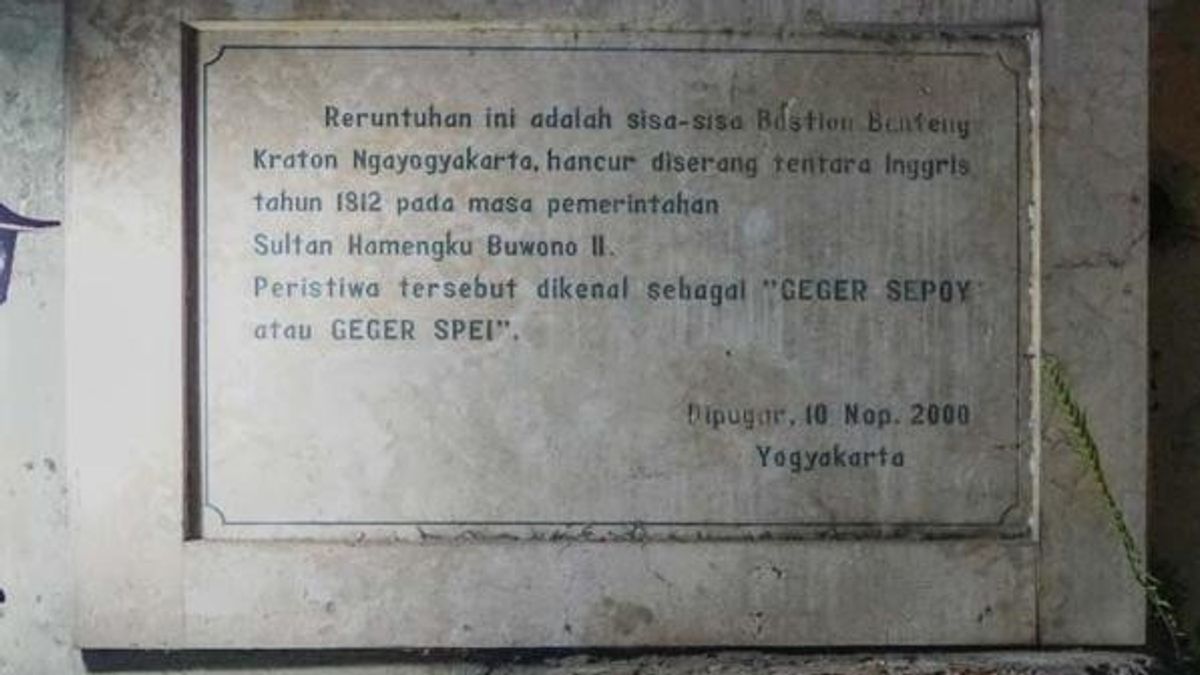JAKARTA - Britain once took over the colonial government of the Dutch East Indies. However, not all kingdoms wanted to obey. The Sultanate of Yogyakarta, for example. Thomas Stamford Raffles and his staff were underestimated.
England did not accept it. The war with the Sultanate of Yogyakarta was launched in 1812. The incident was remembered as Geger Sepoy or Geger Sepeihi. British troops attacked the Yogyakarta Palace to the point of surrendering. The opportunity made the British troops darken their eyes. They looted the treasures and archives of the Sultanate of Yogyakarta.
Thomas Stamford Raffles is an important figure in the presence of England to seize Java. Raffles does have an interest because the island of Java is considered a great civilization that should be researched. This wish is wrapped in a narrative that Britain will benefit if it controls the island of Java.
Raffles also received the blessing of the British government to seize the island of Java from the hands of the colonial government of the Dutch East Indies. Britain also sent Raffles to lead the attack on the heart of the government center in Batavia and succeeded in 1811. Raffles was appointed Lieutenant Governor General of the Dutch East Indies.
He then became the embodiment of British rule in Java. Raffles immediately reminded the kingdoms on the island of Java that Britain is a new ruler. Existing kingdoms are asked to submit and follow Britain's wishes.
Problems arise. There is one kingdom that is considered unwilling to comply with British powers on the island of Java. The kingdom is the Sultanate of Yogyakarta. Sultan Hamengkubuwono II is considered never to want to consider Britain as his new master.
The Raffles envoy received insults and insults from the king who was later nicknamed the Sultan of Sepuh. Raffles was curious. He tried to come to the Yogyakarta leader himself. In fact, what the messenger said was true.
Hamengkubuwono II is stubborn. Raffles was underestimated. The Sultan deliberately arranged for Raffles' seat to be lower. The symbolic meaning is understood by Raffles who studied Javanese culture a lot. Blood spills are close. However, Raffles immediately withdrew and immediately launched the war afterward.
Pakubuwono IV, the leader of Surakarta Flats, is now involved in the conflict. He secretly held correspondence with Hamengkubuwono II which led the Sultan to believe that Surakarta would accompany him in the armed resistance against the European government.
"The real purpose of Susuhunan is to encourage the Sultan to be brave, so that it will lead to the destruction of the sultanate in the hands of Europeans. The British immediately learned of these Surakarta-Yogyakarta correspondences," said historian MC Ricklefs in the book History of Indonesia Modern 1200-2008 (2008).
Sultan Hamengkubowo II is confident that he can survive and win the British attack. He also believes that Surakarta will support him. In fact, the opposite happened. 1,200 British troops actually came with the help of hundreds of Mangkunegara soldiers.
The Sultanate of Yogyakarta remains confident. The Yogyakarta Palace troops were no less numerous. They reached 11,000 people. They are on guard so they can save the Sultan from the British attack. The day he was waiting for arrived in June 1812.
Sultan Yogyakarta's confidence has risen. He tried to weaken the enemy's move by sending an envoy asking the British troops to surrender without fighting. The answer is certainly impossible. Raffles' Nyali has risen. Raffles doesn't care about quantity matters. He focuses on quality.
England also has a slick strategy. They tried to attack the Yogyakarta Palace from all directions. The attack made the Sultanate's soldiers have the guts to tweet. They were attacked by the British from there here and there. Raffles troops were able to attack the Yogyakarta Palace.
Many Yogyakarta soldiers died. While only dozens of British troops died. At its peak, Sultan Hamengkuwono II was pressed and admitted defeat. The defeat made British soldiers furious. They immediately looted the Yogyakarta Palace.
The assets of gold, heirloom objects, and other jewelry - belonging to the Sultanate were stolen a lot. In fact, the looting was also carried out on the residents of Yogyakarta. The incident became a black record in the existence of the Sultanate of Yogyakarta in the archipelago.
Raffles didn't want to be left behind. He did not loot any 'gold' property or other jewelry. He chose to steal a massive academic. Raffles took all the archives belonging to the palace, from the leaf archives to other archives in various languages.
The theft made the Sultanate of Yogyakarta lose a lot of wealth. It may be that assets may be sought. However, historical archives belonging to the Sultanate of Yogyakarta are difficult to return. this condition made the Geger Sepoy incident a massive UK looting of the Sultanate of Yogyakarta.
There was no rape but there were a lot of cracks, and when they robbed them they really went berserk. Around Bangsal Kencono, the daughters and prostitutes were snatched away by their jewelry. Sarongs and kebaya were raided not because of sexual harassment, but to get treasure that might be hidden behind it and the whole city, the looting party took place.
Houses were searched, doors kicked, and everything was taken. British red uniformed troops appeared to be almost completely out of control in looting: they dredged ditches, destroyed cabinets, went down wells, and even dismantled floors so that no small treasure escaped their attention, "wrote Team Hannigan in the book Raffles and British Invasion of Java(2016).
SEE ALSO:
The English, Chinese, Japanese, Arabic, and French versions are automatically generated by the AI. So there may still be inaccuracies in translating, please always see Indonesian as our main language. (system supported by DigitalSiber.id)















